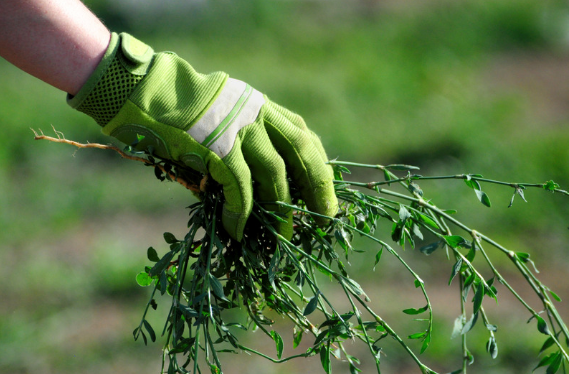Weeds are a gardener’s nemesis, often impeding the growth of your cherished plants. However, reaching for chemical solutions isn’t the only way to fight this battle. As an eco-conscious gardener, you can manage weeds effectively with an organic weed control approach.
In this comprehensive guide, you’ll discover various strategies that align with organic gardening principles, helping you maintain a healthy and vibrant garden without compromising your commitment to the planet.
How to Apply an Organic Weed Control Method

Understanding The Basics Of Weed Growth
Typically, weeds find a foothold due to certain conditions that favor their growth over your desired plants. Poor soil health, often characterized by a lack of essential nutrients or an improper pH balance, creates an ideal breeding ground for weeds.
Additionally, imbalanced moisture levels, whether excessive or insufficient, can encourage weed proliferation. Another critical factor is the lack of competition from other plants. Weeds aggressively exploit open spaces and resources not utilized by other plants.
By understanding these underlying causes, you’re better equipped to implement targeted organic weed control strategies that not only curb weed growth but also foster a healthier, more vibrant garden.
Hiring Experts: Organic Weed Control
Professional weed management involves a combination of methods rather than relying on a single tactic. This holistic approach ensures long-term success and sustainability to help you maintain an organic weed control method.
Weed removal experts start by understanding the specific types of weeds in your garden and the conditions they favor. With this knowledge, you can implement targeted organic weed control practices that disrupt their growth cycle.
Also, consider physical barriers like mulching and regular manual weeding, which removes unwanted growth without disturbing your garden’s ecosystem. With these techniques, you’re creating a garden less susceptible to weed invasions in the long run.
Cultivating Healthy Soil
Enriching the soil with organic matter, like compost or aged manure, is paramount for organic weed control. This not only improves the soil’s structure but also bolsters its nutrient content, fostering a thriving microbial community.
These beneficial microbes are crucial in nutrient cycling, aiding plant growth and resilience. Additionally, well-nourished soil can outcompete weeds, reducing their invasion and growth.
By enhancing the health of your soil, you create a robust foundation for your garden. This ensures your plants can flourish in a balanced, natural environment. Remember, healthy soil is the cornerstone of a thriving, sustainable garden.
Mulching: Your First Line Of Defense
Mulching is your garden’s primary defense against weeds. Not only does it suppress weed growth, but it also enriches the soil underneath.
As you lay down the mulch, it gradually decomposes, enhancing soil fertility and moisture retention. This process creates a less hospitable environment for weeds while nourishing your plants, reducing their likelihood of weed growth.
Mulching—simple yet effective—is a cornerstone of organic weed control in your garden. Remember, the thickness and type of mulch you use can vary depending on your garden needs and the plants you nurture.
Manual Weeding: A Hands-On Approach
Manual weeding is a highly effective yet often underestimated strategy. This hands-on approach requires your direct involvement, where you actively identify and remove unwanted plants from your garden.
The key here is consistency; frequent weeding disrupts the growth cycle of weeds, preventing them from maturing and spreading. This organic weed control method not only offers immediate results but also allows you to monitor closely the health of your garden.
Moreover, manual weeding is an eco-friendly solution, eliminating the need for chemical herbicides. While it may seem labor-intensive, think of it as a way to intimately connect with your garden, contributing to its overall well-being.
Plant Spacing And Coverage
Strategic plant spacing and coverage play a pivotal role in suppressing weed growth. Optimizing the space between your plants creates an environment that’s less inviting to weeds and is a proven organic weed control strategy.
Think of it as employing your plants in a defensive formation against weed invasion. This approach, coupled with ground covers or companion planting, effectively creates a living mulch. Not only does it enhance the aesthetic appeal of your garden, but it also maintains its health by minimizing the opportunities for weeds to gain a foothold.
So, when planning your garden layout, consider the spacing and coverage as crucial elements in your organic weed control strategy.
Regular Monitoring And Maintenance
As a diligent gardener, you should regularly inspect your plants and soil. This proactive approach allows you to spot and address weed invasions early when they’re easiest to control.
Regular weeding, either by hand or with tools, should be part of your routine. It’s not just about removing weeds; it’s also an opportunity to assess soil moisture and health, ensuring that your garden remains in top condition.
If you stay vigilant and attend to your garden consistently, you not only keep weeds at bay but also foster a healthier environment for your plants to thrive.
Final Words
Embracing organic weed control is not only beneficial for your garden but also for the environment. With these strategies, you’re taking steps towards sustainable gardening practices.
The key to success lies in combining different methods tailored to your garden’s needs. By being patient and persistent, you can maintain a beautiful, thriving garden that’s both productive and eco-friendly.
Other posts you might enjoy:
Raised Bed Gardening For Beginners
5 Gardening Tips Guaranteed To Improve Your Garden
8 Tips for Creating the Perfect Garden at Your New Home





